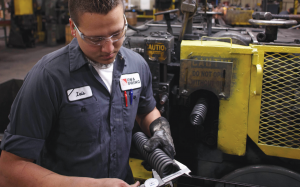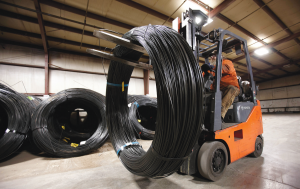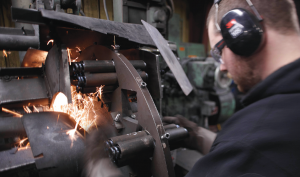
Iowa Spring had a 25-year history of working with CIRAS even before the latest project. The company contacted CIRAS in 2013 to discuss the feasibility of using new technology to create a large spring for its customers’ agricultural equipment.
“Technology to make springs has advanced in the last few years,” said Tim Bianco, Iowa Spring’s president and chief executive officer. The advances include new equipment that makes it easier to bend bigger wire and make larger springs. Large “hot-wound” springs traditionally have been created
Delivery) that all new ideas must follow on the way to becoming an innovation. New ideas are fine tuned, probed, and experimented with to determine their true value, then fleshed out more before they’re brought to market. The RWW framework is part of the Discovery phase—the point where a cross-functional team from a business refines a concept it’s considering investing in by asking three key questions: “Is it Real? Can we Win? Is it Worth doing?”
“Many companies skip the concept Definition and Discovery phases, and jump straight from idea to Development by what Bianco describes as an “antiquated” process of heating metal. Bianco and his team wondered if they could use a “cold-wound” process instead and save their customers money.
CIRAS helped define the idea and put it through a Real, Win, Worth (RWW) framework—a process designed to help company leaders confidently decide whether or not to move forward with a new concept.

The RWW process is part of the Innovation Cycle—a four-step path (Definition, Discovery, Development, and Delivery) that all new ideas must follow on the way to becoming an innovation. New ideas are fine tuned, probed, and experimented with to determine their true value, then fleshed out more before they’re brought to market. The RWW framework is part of the Discovery phase—the point where a cross-functional team from a business refines a concept it’s considering investing in by asking three key questions: “Is it Real? Can we Win? Is it Worth doing?”
“Many companies skip the concept Definition and Discovery phases, and jump straight from idea to Development without testing and proving the value to the customer or the company,” said CIRAS project manager Pete Nadolny. “This is very risky and often why companies fail when trying to deliver innovations to the market.”
Depending on the particular need, CIRAS experts can guide a company through the entire process or only a portion of it, but all the steps must be followed for an innovation to be successful, said Nadolny. “The value we provide is walking companies through how to define a concept and making sure all key things are considered,” he said.
For each key RWW question, CIRAS facilitates sessions that help companies understand the problems, opportunities, and solutions involved in a potential investment, including a look at the true marketplace for a concept and the potential reward.
During different sessions, Nadolny asks questions—Who’s the target customer? What problem will this new concept solve? What’s your proposed solution to this problem? Is it a good fit for our business? What price could we charge? What would it cost to manufacture? “The point is to define exactly what you are proposing to do and why it is going to be valuable to a targeted customer and the company,” he said.
CIRAS’ innovation services “help provide structure to the decision-making process, especially when you’re looking at capital investment, building expansion, or acquiring a different company—anything where you’ll have a substantial investment,” said Brian Setchell, vice president of operations at Iowa Spring. “Our process before was relatively informal, and this brought structure to it. It gets all team members involved.”
Bianco said he recognized the potential benefit for Iowa Spring the first time he heard about CIRAS’ innovation services. “Our management team is diverse in age and experience,” he said. “Anytime we can use an opportunity to look at processes differently, it’s invaluable.”
Nadolny facilitated the RWW approach over several sessions, including administering a questionnaire. Each team member did homework and answered the RWW questions based on the data available and their own perspectives. Answers were tallied, then the team met to debate the results, come to a consensus, and create a final score.
“It was enlightening to learn why each person scored things the way they did. We heard perspectives that I doubt, in our normal process, would have come out,” Setchell said.

Ultimately, Iowa Spring decided it would be worth the money to invest in new equipment and pay for tests of its new cold-wound process using the Center for Nondestructive Evaluation at Iowa State University. Tests showed that the new cold-wound spring outlasted a sample hot-wound spring. “We’ve come up with a solution that can save customers money but give them the same performance,” Setchell said.
Response by customers has been positive. Iowa Spring expects as much as $1 million in increased sales annually from the cold-wound innovation, which also reduces the company’s manufacturing costs by more than 30 percent. Iowa Spring already has invested $1.2 million in equipment that will expand its production capabilities.
On the heels of the first RWW project success, Iowa Spring enlisted CIRAS’ help on a second project. The company had an opportunity to acquire a California manufacturer that has a presence across North America and to grow alongside one of its current customers, a company that’s looking to expand its business on the West Coast. “It was another chance to use the Innovation Cycle and RWW,” Bianco said.
Based on the results of the RWW approach, Iowa Spring plans to move forward with trying to acquire the California spring company, its main competition in that region. Bianco said a successful acquisition would allow Iowa Spring to retain 20 percent of its volume, service a marketplace that isn’t being serviced, and create top line, organic growth.
Bianco described the RWW framework as a “true methodology you can use that’s tried and practiced.”
“We’re going to continue to use this system every time we have an opportunity,” he said. “It’s inexpensive and not time consuming. We have the process map, we just need to follow it.”
Setchell agreed. “We have decided, after doing RWW, that on future projects we’re going to have that be the driver for how we meet and make our decisions,” he said.
Moreover, Bianco, who is the second generation to run his family’s company, appreciates the long-term relationship Iowa Spring has had with CIRAS. “We’re in a mature marketplace that’s tough to distinguish yourself in, and we’ve made ourselves unique.”
He credits CIRAS with helping them to do that.
This article originally appeared in the Spring 2015 edition of CIRAS News. You can find the rest of this issue and more on our website.